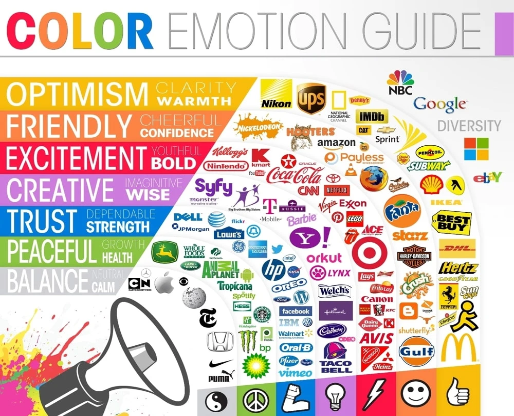
When you hear the phrase corporate branding, you might think of industry titans—car companies, ubiquitous hotel chains, and fast food arches.
Despite this association, corporate branding applies to businesses of all sizes, not just the giants with unlimited marketing budgets.
To better understand the role corporate branding plays, I’ve broken down the impact of corporate branding to help you know how it can drive your business forward, no matter how big or small your business is.
What Is Corporate Branding and Why Is It Important?
Think of your favorite brand (or one you interact with regularly.) What comes to mind? Do you think of their tagline? The logo? The color palette? The chosen ambassador?
These assets, among many others, are what make up corporate branding. Corporate branding is the outward projection of a brand’s mission and culture in colors, logo, tone, and design.
A successful corporate brand encompasses an organization’s goals, mission, and ideology and appears across all mediums (website, packaging, copy, ads, etc.) to ensure visual consistency.
A strong corporate branding strategy focuses on a wide range of assets, from details as small font and color options and as large as building structure and slogan.
This element might seem too complicated to enact at your organization, but corporate branding is vital to all businesses, from small local businesses to massive ecommerce brands.
Emotions play a large role in marketing, and when a consumer relates to your brand’s values, they build an emotional connection with your brand. These emotional connections increase customer loyalty, not to mention profits and word-of-mouth advertising.
How Corporate Branding Increases Sales
Companies with robust corporate branding strategies attract and maintain new customers, increase community interest, and improve overall marketing strategy.
Companies with strong brand affiliation offer a 31% higher shareholder return than their contemporaries.
In addition to increasing shareholder return, corporate branding fosters employee engagement and encourages 3x faster profit growth than an organization without a strong branding strategy.
While this might feel unattainable to small businesses without huge marketing budgets, the truth is, your organization can increase growth through a strong corporate branding strategy.
Here are five ways corporate branding can change how your potential consumers view your brand—and drive profits.
Corporate Branding Conveys Brand Personality
Brand personality refers to the personification of your company’s mission. This personality is conveyed through the style, voice, and tone you use in your business’ communication.
Just like we tend to judge people based on first impressions, your brand’s personality impacts how consumers perceive your organization from the start.
When building your brand’s personality, include language and sentiments that ring true to your mission and resonate with prospective customers.
A strong brand personality will help:
- Distinguish you from competitors
- Increase immediate recognition
- Build an emotional connection
Corporate Branding Improves Customer Relationships
Building a strong customer relationship isn’t just good business; it costs less, too. The average company spends five times more to attract new customers rather than focusing on keeping more of the customers they already have.
Like any relationship, the bond between you and your customer needs to be nurtured to grow.
With a corporate branding strategy, interactions with prospective consumers become a comfortable exchange. By including your organization’s voice and mission in all of your content and customer experience, you establish a shared relationship with your customer.
These two strategies can help your further nurture that connection:
- Share success stories: Everyone likes to feel like they belong, so sharing user-generated success stories is an excellent way to encourage consumers to engage with your brand. The beauty of user-generated content is in its creation. Since it’s not coming directly from your business, it feels more trustworthy and intimate, helping to foster a sense of community.
- Personalize communication: Personalized marketing can increase customer engagement. Using first names and other pertinent information can further the bond between buyer and seller, making the relationship feel more organic rather than sales-based.
Corporate Branding Sets Your Brand Apart
The internet is home to roughly 3.17 billion active social media users. The majority of companies are well aware of this statistic and harness an average of five social mediums to connect with those users.
This fact means the average consumer sees hundreds of advertisements daily.
To help your business be heard and seen online, you need to be one of many scrolled-past advertisements—you need to stand out.
Corporate branding can help you share your brand’s story. That story serves as a hook to draw your audience in and make you more than a company, but a community they can relate to.
Corporate Branding Boosts Customer Loyalty
The Pareto Principle says 80% of revenue originates from 20% of your existing consumer base. That percentage quantifies just how important it is to ensure customers are loyal and return to your business again and again.
After you’ve worked to foster strong customer relationships, you want to ensure those relationships last.
By growing your corporate branding strategy and incorporating it into new mediums and platforms, you ensure your message is reaching and resonating with your current base.
Consider offering a loyalty deal to your most valuable consumers to further build loyalty.
When people feel valued, they are much more likely to purchase from the company providing value. Nearly 60% of loyal customers make more purchases with their preferred companies, so building and establishing trust and loyalty can impact your bottom line.
Building a Corporate Brand
Building a brand is a long, ongoing process, but there are seven simple steps you can enact today to begin your journey to a memorable brand.
Get to Know Your Intended Audience and Your Competitors
Before wedding yourself to any decisions about your brand, get to know both your ideal customers and direct competitors. You can learn more about the shape of the market by:
- Conducting a web search of your product
- Exploring social media accounts followed by your target audience
- Speaking with individuals in your target audience to learn what products they are purchasing
Use a tool like Ubersuggest to explore what your competitors are doing. Look at the colors, phrasing, and images they use to connect with their audience and consider if similar branding aligns with your mission. (Just make sure your branding is original!)
Create a Mission Statement
A mission statement is a summary of your company’s goals and values. Your mission is the driving force behind your brand and is vital to align your audience with your business.
When creating your mission statement, ask these questions:
- What’s the purpose of providing our services and products?
- What do we aim to change in our consumers’ lives?
- Why is this change significant?
- What drives us?
Use the answers to craft a statement that outlines who your audience is, what your brand contributes, and what makes your product or service different.
Identify Your Brand Personality
Brand personality helps customers connect with your brand and build customer confidence. When choosing what you want to embody, use these questions to get started:
- Who would be the spokesperson for the brand?
- Which adjectives are connected to the brand?
- What is your brand’s value proposition?
After you’ve established a value proposition, use it to create a positioning statement that clearly outlines your target market and how you want your brand to be perceived.
Write a Slogan (or Write a Bunch of Slogans!)
A slogan is a short, catchy phrase associated with your organization that shares your product or service’s driving benefit. Ideally, your slogan should become completely synonymous with your brand, like McDonald’s “I’m lovin it!” jingle.
However, creating a catchy slogan can be challenging—you have a lot to say in very few words. Here are six tips to help you create a catchy slogan that encapsulates your brand’s essence.
- Short and to the point: Most slogans are curt (think: ‘Just Do It’ or ‘America runs on Dunkin’’). You know what the essence of your organization is, so make sure you convey it to your consumer concisely.
- Remember your target consumers: Whether you’re a local brand shipping nationally or a company going global, be sure to keep your consumer in mind. A slogan that may delight New Jersey residents may have the opposite effect on those on the West Coast.
- Draw on what differentiates you: Build on what makes your business stand out from your competitors by highlighting your value proposition.
- Consistency is key: Corporate branding is all about consistency. This tenet applies to your slogan, as well. Ensure your slogan represents your brand’s personality and serves as a verbal and visual manifestation of your ideals.
- Ensure a long shelf life: You don’t want to come to the unfortunate realization your slogan has lost its relevance after just a year or two. Consider the longevity of your slogan and how it can persist even in a fast-changing industry.
- Be sure your slogan can stand alone: If a new customer encounters your logo, they should know what your organization offers and what your brand does. By ensuring your slogan can stand alone, you eliminate confusion about your brand’s identity.
Select the Visual Manifestation of Your Brand
Colors and typography guide how your audience views your brand, so you want to make sure you choose the right one. Here are a few factors to consider when choosing your brand’s colors:
- Choose a color palette that matches your brand’s personality. Consider how color psychology impacts how your brand is perceived.

- Choose typography that makes sense for your brand and audience.
- Create a brand style guide to ensure consistency across platforms and mediums.
Design Your Logo
Your logo is the face of your company, so it should represent your brand’s personality and be memorable enough to be recognized anywhere.
The good news is, you don’t have to drop thousands of dollars; there are plenty of free tools to help you create a professional logo.
As you design your logo, ask yourself these questions:
- What best represents the organization?
- Do you want to include a tagline in your logo?
- Do you prefer a text-based logo or an image-based logo or a hybrid?
Put Your Corporate Branding to Work
You’ve spent a lot of time and effort identifying your target consumers, developing your story and personality, and determining the right font and colors for your brand.
It’s time to put all of those pieces together and deploy your corporate branding strategy. Keep in mind a corporate brand should be incorporated everywhere.
Don’t forget to include your branding strategy in your:
- Email signature
- Social media presence
- Videos
- Physical items, like corporate swag
- Office design (if applicable)
Using your corporate brand everywhere your customers interact with your brand ensures consistency, which builds trust and increases engagement.
Conclusion
Building a brand story and creating a corporate branding strategy for your business is no small task—but it can increase trust, encourage engagement, and drive profits.
As you craft your corporate brand, keep your customer and your mission statement at the center to ensure your branding resonates and connects with your ideal customer.
What is the most effective corporate branding strategy you’ve used?
source http://feedproxy.google.com/~r/KISSmetrics/~3/rS8qfXm_UMU/
No comments:
Post a Comment